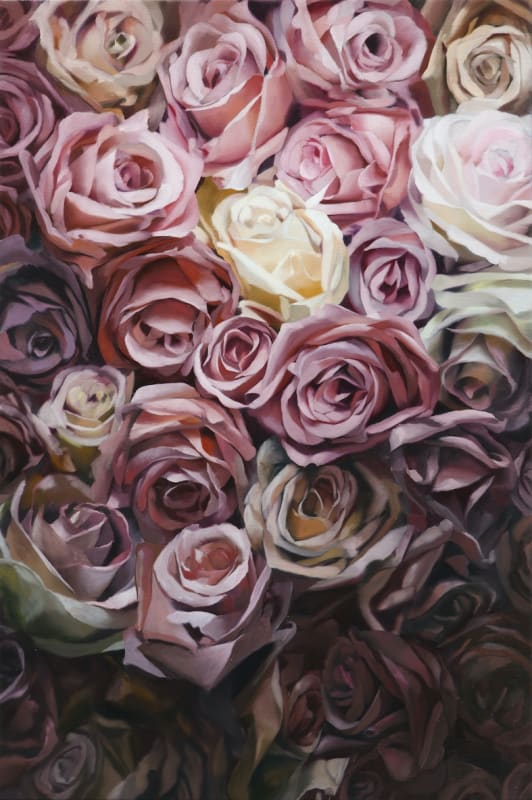In 1826, when Henry Beyle, known as Stendhal, wrote about his trip to Italy in his book "Rome, Naples and Florence", he effusively described the emotional outpouring he experienced while contemplating the frescoes in the Niccolini Chapel during a visit to the Basilica of Santa Croce. This strange uneasiness that struck him at the time, a very physical sensation of vertigo induced by an overflow of beauty, would later give its name to a documented disorder in psychiatry: the Stendhal Syndrome.
For Stendhal, as for Åkesson, beauty delights as much as it devastates. It insinuates itself into each interstice of the painting in the form of obsessive ornamental motifs, replicated in series on the moired fabrics that cover the backgrounds and the bodies from head to toe. Here, nothing appears of the characters that populate these portraits. They are no longer the very individuals, but the allegories of an enigma that Markus Åkesson seeks to uncover. What is it?
Since several years, the Swedish artist has been encrypting on canvas or engraving on glass, with patience and meticulousness, some maze-like narratives where art history, esotericism, mythology and human psyche are intertwined. "I want to control the story told by the motif. The symbols linked together deepen the narrative level of the painting, some parts of the story are thus voluntarily hidden" he explains. The models, wrapped in fabric, betray the subtext buried in the subject, a more obscure level of reading like in those ancient fables that imply several morals. The interpretation, voluntarily opened, thus depends on the degree of the spectator's complicity. Will he stay on the surface, caught up in the formal and aesthetic seduction of the work? Or will he pull the thread of the abstruse canvas woven by the artist, falling from lower to lower, burrowing deeper and deeper into the meanders of the dream?
In his recent works, Markus Åkesson invites the artistic figures of Albrecht Dürer, from whom he quotes "The Apocalypse" (1496-1498) and "The Witch" (ca. 1500), and Sir Lawrence Alma-Tadema, from whom he borrows his "Heliogabalus Roses" (1888). Because these latter have studded these works with mysterious details that intrigue him as an artist, Åkesson will set his own pace in the footsteps of his peers. And to a question of visual order, he will try to answer in the same language, that of plastic. These sources of inspiration reveal the persistence of a fascination for the strange, or rather for the disturbingly strange. The History of Augustus reports that Heliogabalus, a sulphurous Roman emperor whose reign was as short as its decadence, was said to have thrown orgiastic banquets during which heaps of flowers were suddenly poured on the guests, in such quantities that some of them ended up suffocating. In Alma-Tadema's painting, as in Åkesson's tributes to him, the surfeit of beauty and refinement stretches the work to the edge of nightmare. After all, don't Åkessonian figures suffocate under the weight of the luxurious iconography that camouflages them?
Over the last few years, the Swedish artist has materialized in his work a renewed form of "art for art's sake" dear to the British Aesthetic Movement and the Arts and Crafts movement. Thus, his glass sculptures set with gold and scattered with alchemical motifs, remind us of ancient oriental incense pots and other precious jars, without however having any function. Only the decorative and aesthetic dimension, as well as the enigma dissolved in the detail, count. Because they seem entirely dedicated to the visitor's visual or tactile pleasure, Markus Åkesson's works cause an emotion that is capable, as in Stendhal, of making us vibrate as it makes us falter. And it is exactly at the top of this fine ridge between comfort and discomfort, between charm and danger, excess and artifice that he prefers to evolve.
Fanny Giniès
